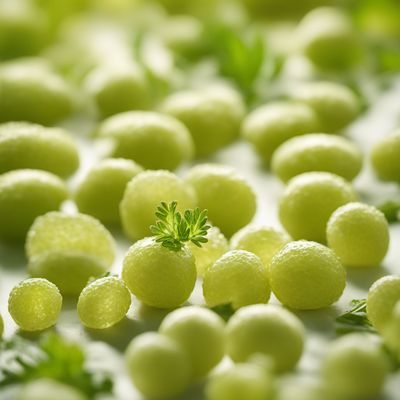
Ingredient
Woodruff, dry
The Fragrant Herb: Unveiling the Secrets of Dry Woodruff
Dry woodruff, also known as Galium odoratum, is a perennial herb that belongs to the Rubiaceae family. It features small, lance-shaped leaves that grow in whorls around the stem, giving it an attractive appearance. The herb has a distinct fragrance, reminiscent of freshly mown hay and vanilla. In terms of texture, dry woodruff leaves are soft and pliable, making them easy to work with in culinary preparations. The dried form of woodruff is commonly used in cooking and infusions due to its concentrated flavor.
Origins and history
Native to Europe, dry woodruff has a rich historical background. It has been used for centuries in traditional European herbal medicine for its various health benefits. In culinary traditions, it gained popularity as a flavoring agent in beverages like May wine and German Maibowle. Woodruff was also used to ward off evil spirits and as a strewing herb to freshen the air in medieval times.
Nutritional information
Dry woodruff is low in calories and does not provide significant amounts of macronutrients. However, it contains small amounts of essential oils, tannins, and coumarin compounds, which contribute to its aromatic and medicinal properties.
Allergens
There are no known allergens associated with dry woodruff.
How to select
When selecting dry woodruff, look for leaves that are vibrant green in color and free from any signs of discoloration or mold. The leaves should have a strong, pleasant aroma. Opt for reputable brands or suppliers to ensure the highest quality.
Storage recommendations
To maintain the freshness and quality of dry woodruff, store it in an airtight container in a cool, dry place away from direct sunlight. Properly stored, it can retain its flavor for up to a year.
How to produce
Dry woodruff can be grown in a home garden by planting seeds or transplanting young plants into well-draining soil. It thrives in partial shade and requires regular watering. Harvest the leaves when they are at their peak freshness, and dry them in a cool, dark place until they become brittle.
Preparation tips
Dry woodruff can be used in various culinary applications. It is commonly used to infuse beverages like tea, lemonade, or cocktails, imparting a delightful aroma and flavor. It can also be added to desserts, such as custards, ice creams, or baked goods, to enhance their taste. When using dry woodruff, it is important to remember that a little goes a long way, as its flavor can be quite potent.
Culinary uses
Dry woodruff is widely used in traditional European cuisines. It is a key ingredient in May wine, a German beverage traditionally enjoyed during spring festivals. The herb is also used to flavor liqueurs, such as the famous German Waldmeisterbowle. Additionally, dry woodruff can be incorporated into jellies, syrups, and herbal teas to add a unique twist to the flavors.
Availability
Dry woodruff is commonly available in Europe, particularly in Germany, where it is widely cultivated. It can also be found in specialty stores or online retailers that offer a wide range of culinary herbs and spices.
More ingredients from this category » Browse all

Sweet cicely, dry
The Delicate Herb: Sweet Cicely

Wintergreen leaves, dry
Nature's Minty Delight

Rue, dry
The Bitter Herb: Unveiling the Secrets of Dry Rue

Angelica, dry
The Heavenly Herb: Unveiling the Secrets of Dry Angelica

Borage, dry
The Vibrant Herb of Delight

Celery leaves, dry
The Flavorful Herb: Dry Celery Leaves

Bay leaves, dry
Aromatic Leaf of Flavor

Mints, dry
The Versatile Herb: Unlocking the Aromatic Power of Dry Mints

Lavender, dry
The Fragrant Herb: Lavender

Basil, dry
The Fragrant Herb: Dried Basil

Hyssop, dry
The Aromatic Herb: Unveiling the Secrets of Dry Hyssop

Fennel, dry
The Fragrant Spice of the Mediterranean